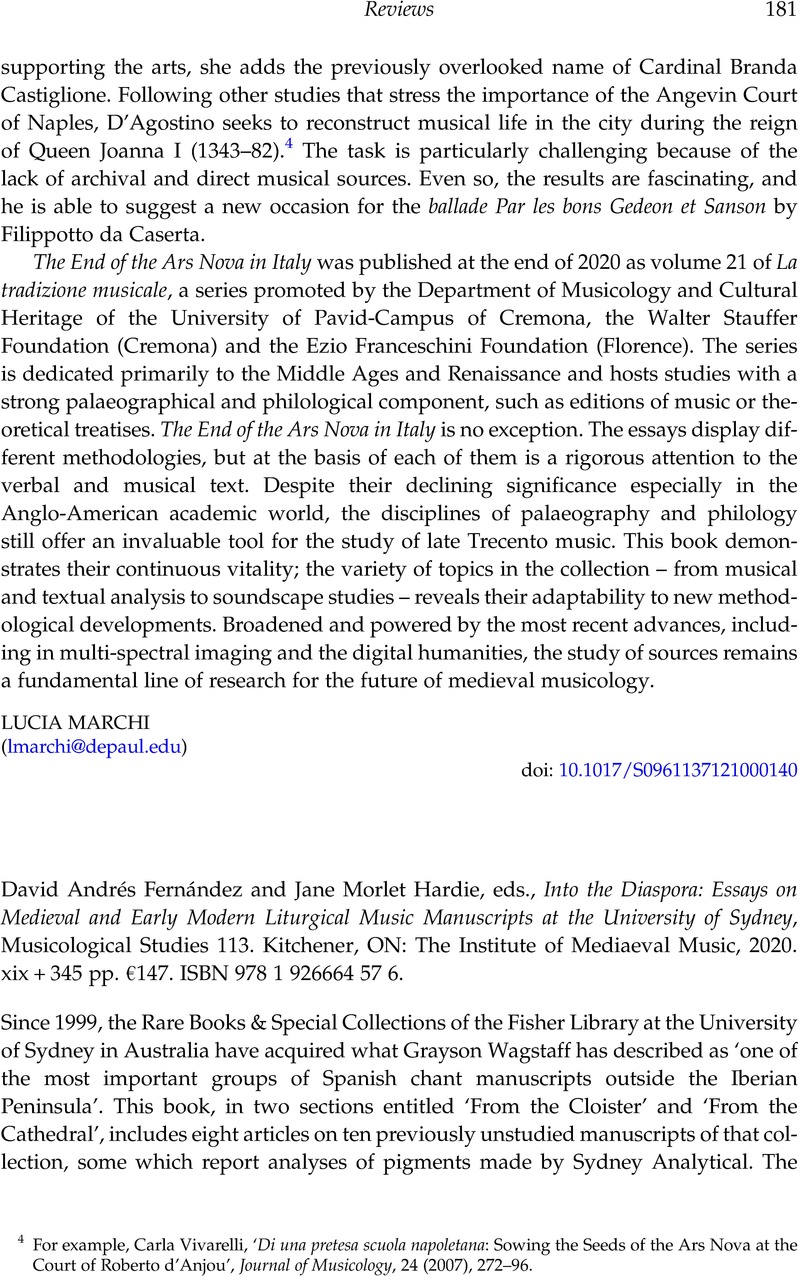Article contents
David Andrés Fernández and Jane Morlet Hardie, eds., Into the Diaspora: Essays on Medieval and Early Modern Liturgical Music Manuscripts at the University of Sydney, Musicological Studies 113. Kitchener, ON: The Institute of Mediaeval Music, 2020. xix + 345 pp. €147. ISBN 978 1 926664 57 6.
Review products
Published online by Cambridge University Press: 08 February 2022
Abstract

- Type
- Review
- Information
- Copyright
- Copyright © The Author(s), 2022. Published by Cambridge University Press
References
1 Fernández, David Andrés, Mapping Processions: Four Sixteenth-Century Spanish Music Manuscripts in Sydney, ed. Hardie, Jane Morlet (Kitchener, ON, 2018)Google Scholar, which discusses Mss. 358, 380, 406 and 407; reviewed in Plainsong & Medieval Music 28 (2019), 92–7.
2 The chants for Corpus Christi, the antiphons Sapientia and Angelorum esca, were widely sung as the first two at Lauds; the responsory Panem celi was most often sung at Terce. Here they were intended for a procession.
3 Haggh, Barbara, ‘The Meeting of Chant and Polyphony in Monophonic Square Notation from Cambrai Cathedral, 1250–1550’, in The Calligraphy of Medieval Music, ed. Haines, John (Turnhout, 2011), 253–72CrossRefGoogle Scholar, at 258–63.
4 Another variant of the basic antiphon, CAO 4703, with the same text incipit was sung as the Magnificat antiphon for first Vespers of an office for the Virgin of the Pillar, as attested in a printed book without notation, Mexico City, Cathedral Archives, XXIX-76-28: Proprium Sanctorum Hispanorum, the Autumn 1805 Supplement to the Breviarium Romanum (Madrid, 1806), 39–41. See Barbara Haggh-Huglo, with Eric Pazdziora, Simon Polson and Ruisard, Rachel, ‘New and Borrowed Chant in New Spain and Mexico: The Offices for the Espousal of the Virgin, the Seven Sorrows of the Virgin, the Virgin of the Pillar and the Virgin of Guadalupe’, Études grégoriennes 44 (2017), 111–75Google Scholar, at 148, 150.
5 Hardie assesses Alleluia verses to Passion Sunday, whereas most of the scholarship concentrates on the weeks after Easter. To that bibliography, some of which she cites, should be added Hiley, David, ‘Post-Pentecost Alleluias in Medieval British Liturgies’, in Music in the Medieval English Liturgy: Plainsong & Mediaeval Music Society Centennial Essays, ed. Rankin, Susan and Hiley, David (Oxford, 1993), 145–74Google Scholar. Note that Alleluia verse series for the period after Easter can be searched online at Cantus Planus Regensburg: www.uni-regensburg.de/Fakultaeten/phil_Fak_I/Musikwissenschaft/cantus/.
- 1
- Cited by





